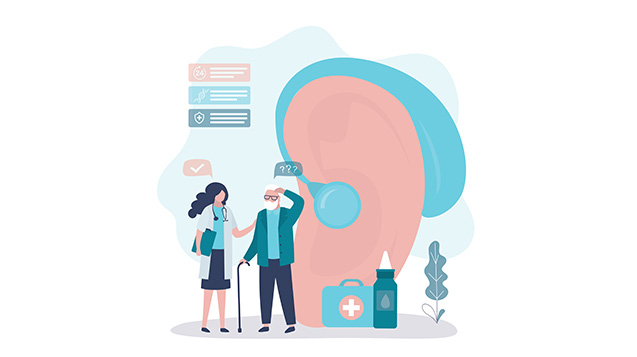4 Things to Know About Those New Apple Hearing Aids

Get a Closer Look (and Learn Why Professional Care Is Critich3)
With hearing technology evolving, innovations bring clearer sound, stronger connections, and more empowerment in daily life. New options can offer better access to improved hearing and its benefits.
Have you heard about the Apple AirPods* Pro 2 Hearing Aid feature and its market impact? As your trusted provider, we’re here to keep you informed. Let’s explore this technology and why professional care matters. Read on for four things to know about these devices.
1. Managed Through Software
Apple AirPods Pro devices — wireless earbuds for listening to music, calls, and other audio — have been around for a few years. Their functionality expanded further in September 2024 when the U.S. Food and Drug Administration (FDA) approved software called the “Hearing Aid feature” to adapt compatible earbud models into hearing aid instruments.
The Hearing Aid feature (HAF) requires an iOS-powered mobile device — an iPhone or iPad — for setup. With information on the person’s hearing levels drawn from the updated device’s built-in Hearing Test feature or an audiogram from a hearing health care professional, the HAF is reportedly tailored to the earbud wearer. The user can then further adjust the volume and other settings.
2. Designated as an “Over-the-Counter” Device
Over-the-counter (OTC) hearing aids are regulated medical-grade hearing devices — authorized and available only in some countries — that can be bought by the user without a hearing evaluation, prescription, fitting, or other assistance by a trained professional. They’re a fairly new option, which, in theory, could bring hearing help to more people.
However, over-the-counter hearing aids are authorized only for people 18 and older with mild to moderate hearing loss.
3. Available Only in Limited Areas
Much like pacemakers, CPAP machines, and implantable cardioverter defibrillators, hearing aids have traditionally been prescription only, requiring a licensed hearing care provider. Underlying health considerations, alignment with specific hearing needs, and other factors play a big role in determining the best solution, so it’s no small matter to allow OTC sales.
Apple announced in a summer 2024 news release that it expected the Hearing Test and Hearing Aid features to be available that fall in over 100 countries and regions. In North America, for example, Apple hearing aids are available in the U.S. due to:
- Federal legislation passed in 2017 authorizing OTC devices that meet national regulations, which were later released in 2022
- FDA approval in September 2024 of the HAF software — for use with compatible Apple AirPods Pro devices
Canada doesn’t have legislation authorizing over-the-counter hearing aids. Similar to the United States before U.S. OTC regulation, Canada requires the purchase of hearing aids through a licensed hearing care professional authorized to provide prescription devices.
Whether or when OTC hearing aids become authorized in Canada is unclear. Until then, the Hearing Aid feature software wouldn’t likely be available for use with Apple AirPods Pro devices in Canada.
4. Different From Provider-Fit Hearing Aids
Hearing loss can take a toll on the brain, making it work harder to process sound; taxing valuable resources needed for other brain functions; potentially reducing capacity for thinking and remembering; and possibly leading to brain changes from sound deprivation. This makes it more important than ever to have devices matched to your particular hearing needs.
Apple hearing aids and other OTC devices can bypass the assistance of a trained professional. This could mean under- or overtreating hearing loss. It could also mean missing out on the benefits of professionally fit technology, such as:
- Custom fitting of prescription-level devices personalized to your actual hearing needs
- Professional monitoring to help ensure you’re adjusting to using hearing technology
- Comprehensive evaluation to rule out other causes of hearing loss, such as earwax buildup
- Provider follow-ups and clean and checks to make sure devices are working their best
- Solutions that don’t just amplify but also adjust to environmental changes to help the brain process sound
Most importantly, provider-fit hearing aids — regulated and recommended as medical devices — are meant for the full range of mild to profound levels of hearing loss. They support improved sound comprehension and can be programmed and fine-tuned to fit one’s individual listening needs. Plus, an appropriate prescription is available for people in nearly every stage of life.
Used as hearing aids, Apple AirPods Pro devices may mark an exciting moment in the evolution of hearables. As with OTC hearing devices generally, however, the self-treating aspect potentially omits a professional diagnostic evaluation that can provide a baseline of your hearing levels, pinpoint possible problems, and yield critical solutions.
The growing choices in hearing technology highlight the need for professional care. If it’s been a while since your last hearing checkup or engaging with the world around you seems harder than it used to be, don’t wait. Contact us to book your personalized appointment today. We’re HEAR to help!
*Apple and Apple AirPods are trademarks of Apple Inc., registered in the U.S. and other countries and regions.
